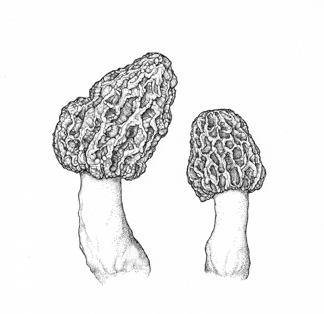Well over 1,000 species of wild mushrooms have been described in the state of Connecticut. The word mushroom includes any conspicuous fleshy fungus. Often times, people use the word ‘toadstool’ interchangeably with wild mushroom. The word ‘toadstool’ is commonly used to refer to poisonous or inedible mushrooms but has no scientific merit.
When characterizing mushrooms found in the wild, field information that should be taken into consideration can be summarized as follows:
- Presence/absence of universal of partial veil
- Gill attachment: or in what manner gills are attached or not attached to the stalk
- Mass color of the spores in a spore print
- Cap characteristics: shape, size, color, special features, fleshy or tough
- Stalk characteristics: texture, length, diameter, shape
- Grouping of mushrooms: single, loosely scattered, clustered
- Habitat: lawn, grassy area, growing from downed wood, base or on of a living tree, on the ground in deciduous or coniferous woods
There is a challenge in finding certain mushrooms during their ‘season’ when they suddenly appear and almost as suddenly disappear. One must carefully and extensively study the characteristics of both edible and inedible species before consumption. There is no simple test to rule out dangerous mushrooms from the small selection of edible mushrooms. Here are some resources available to the mushroom enthusiast:
Connecticut Valley Mycological Society
All That the Rain Promises and More: A Hip Pocket Guide to Western Mushrooms, by David Arora. Ten Speed Press, Berkeley CA.
A Field Guide to Mushrooms: North America (Peterson Field Guides), by Kent H. McKnight and Vera B. McKnight. Houghton Mifflin Company, 215 Park Avenue South, New York, NY 10003
Mushrooms Demystified, by David Arora. Ten Speed Press, Berkeley CA.
University of Connecticut does not identify mushrooms and strongly urges the public not to consume wild mushrooms unless you are able to identify it with one hundred percent certainty and know it is safe for eating. Even safe mushrooms can cause allergic reactions in some people. Strictly avoid any mushroom that looks like an Amanita, all little brown mushrooms, and all false morels. Should you become ill from eating wild mushrooms, contact a physician or the nearest hospital.

(photo from thegreatmorel.com)
by Cecily Varvitsotis, UConn Home and Garden Education Center
Revised by UConn Home and Garden Education Center 2016.
Issued in furtherance of Cooperative Extension work, Acts of May 8 and June 30, 1914, in cooperation with the U.S. Department of Agriculture, the Dean of the College, Cooperative Extension System, University of Connecticut, Storrs. The Connecticut Cooperative Extension System is an equal opportunity employer and program provider. To file a complaint of discrimination, write USDA, Director, Office of Civil Rights, Room 326-W, Whitten Building, Stop Code 9410, 1400 Independence Avenue, SW, Washington, DC 20250-9410 or call (202) 720-5964.